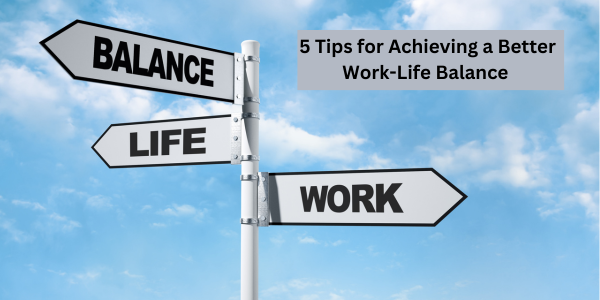 Let’s talk about an important topic today, i.e., work-life balance. To begin with, let’s start with the meaning i.e., the equilibrium between one’s professional commitments and personal life responsibilities. It involves effectively managing and prioritizing work-related tasks and responsibilities while also taking care of personal well-being, family, relationships, and leisure activities.
Let’s talk about an important topic today, i.e., work-life balance. To begin with, let’s start with the meaning i.e., the equilibrium between one’s professional commitments and personal life responsibilities. It involves effectively managing and prioritizing work-related tasks and responsibilities while also taking care of personal well-being, family, relationships, and leisure activities.
What does work-life balance look like?
Work-life balance looks like a harmonious integration of work and personal life, where individuals effectively manage their time and priorities to achieve fulfillment in both areas. It involves setting boundaries and allocating sufficient time for work-related tasks, personal responsibilities, and activities that promote well-being. For example, work-life balance may involve having flexible work hours to accommodate personal commitments, dedicating quality time for family activities, pursuing hobbies or self-care routines, and consciously disconnecting from work during non-work hours. It means finding a healthy equilibrium that allows individuals to thrive professionally while nurturing personal relationships, engaging in self-care, and pursuing interests that bring joy and fulfillment. Ultimately, work-life balance is subjective and unique to each person’s needs and preferences.
Also Read: A framework for Remote and Hybrid Learning
Why work-life balance is important?
The most important part is to understand and know the relevance of work-life balance, it is crucial for maintaining physical and mental well-being, as well as overall satisfaction and happiness. It allows individuals to allocate time and energy to both work-related commitments and personal responsibilities, interests, and relationships.
Not just this, a healthy work-life balance helps prevent burnout, reduces stress levels, and promotes better overall health. It enhances productivity and job satisfaction by allowing individuals to recharge, rejuvenate, and maintain a sense of fulfillment outside of work. Moreover, work-life balance nurtures and strengthens personal relationships, fosters personal growth and development, and enables individuals to lead a more fulfilling and meaningful life. By striking a balance between work and personal life, individuals can achieve greater happiness, success, and long-term satisfaction in all aspects of their lives.
Work-life balance for employees these days can vary significantly depending on the industry, company culture, and individual circumstances. However, in many cases, achieving a healthy work-life balance has become increasingly challenging. The demands of modern work, such as long working hours, heavy workloads, and constant connectivity through technology, often blur the boundaries between work and personal life. Many employees find themselves grappling with the pressure to always be available and the difficulty of disconnecting from work-related responsibilities. This can lead to increased stress levels, burnout, and negative impacts on mental and physical well-being. Nevertheless, there is a growing awareness of the importance of work-life balance, and organizations are increasingly implementing policies and initiatives to support employees in finding this balance. Flexible work arrangements, remote work options, wellness programs, and emphasis on prioritizing self-care are some of the strategies being adopted to address the work-life balance challenges faced by employees today.
Also Read: Embracing the Future: Work and Learning in the Age of Automation
To help everyone out there. We are listing down 5 ways that can help you improve your work-life balance:
- Set Clear Boundaries: One should set clear boundaries between work and personal life. Define specific work hours and non-work hours and aim to maintain them. One must avoid taking work-related calls or checking emails during personal time, and similarly, avoid engaging in personal activities during work hours.
- Prioritize and Delegate: One must prioritize and focus on tasks that truly matter. The tasks should be delegated further whenever possible to lighten the workload. Effective prioritization and delegation help one avoid becoming overwhelmed and allow one to allocate time and energy to both work and personal life.
- Practice Effective Time Management: One must adopt time management techniques to maximize productivity. To make things easier you can use tools such as calendars, to-do lists, and time-blocking methods to organize and schedule your tasks efficiently. One must avoid multitasking, as it can lead to decreased productivity and increased stress.
- Take Regular Breaks: Breaks are essential for rejuvenation and maintaining a healthy work-life balance. Incorporate short breaks throughout your workday to relax, stretch, or engage in activities that help you recharge. Additionally, schedule regular vacations or time off to completely disconnect from work and focus on personal well-being.
- Establish Self-Care Routines: Prioritize self-care to maintain physical and mental well-being. Engage in activities that help you relax, reduce stress, and improve overall health, such as exercising, practicing mindfulness or meditation, pursuing hobbies, and spending quality time with loved ones. Taking care of yourself allows you to bring your best self to both work and personal life.
Always keep in mind that achieving work-life balance is an ongoing process that requires conscious effort and adjustments. It’s important to regularly assess and reassess your priorities, boundaries, and self-care practices to ensure a healthy integration of work and personal life. By implementing these strategies, you can improve your work-life balance and experience greater overall satisfaction and well-being.

























